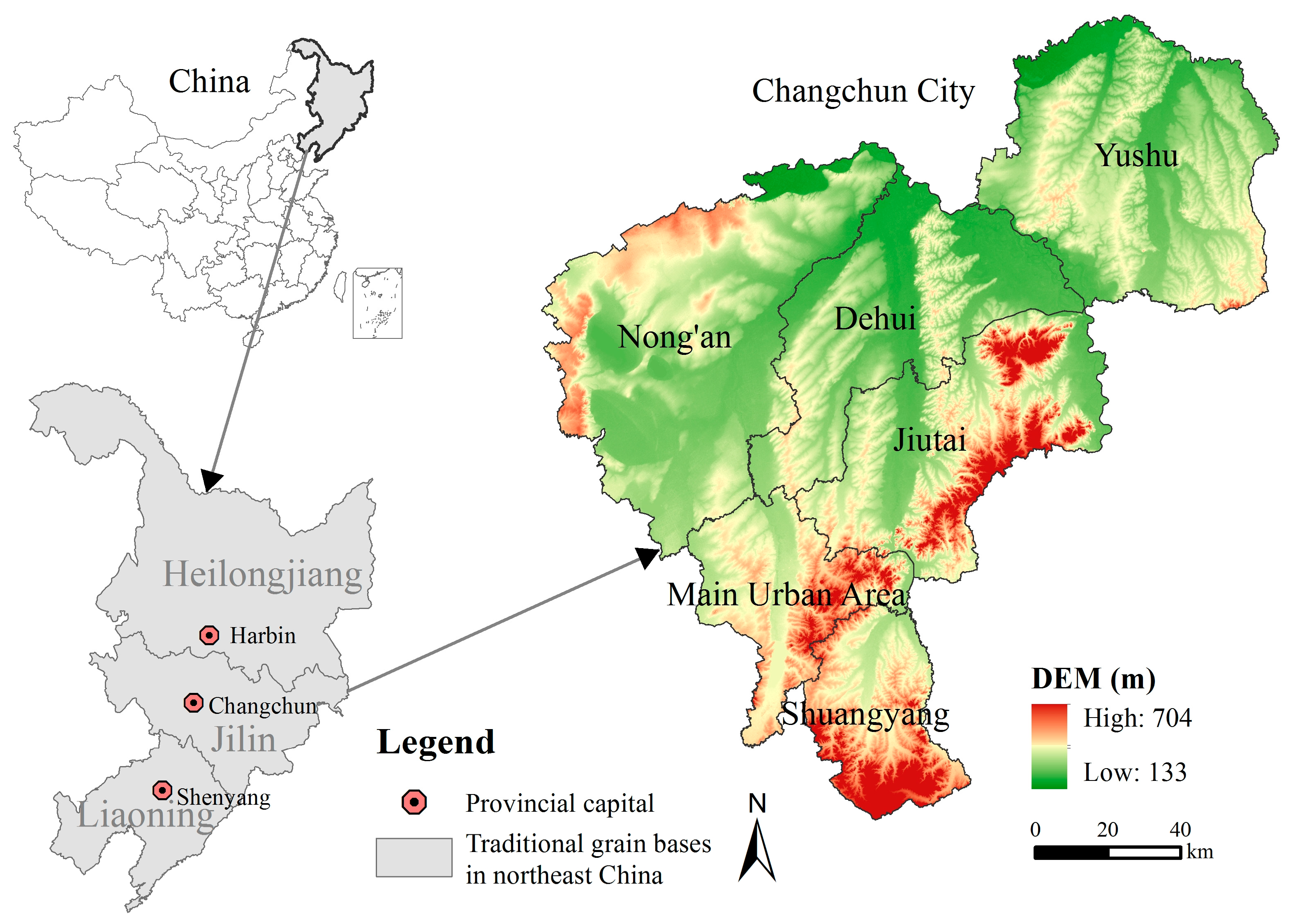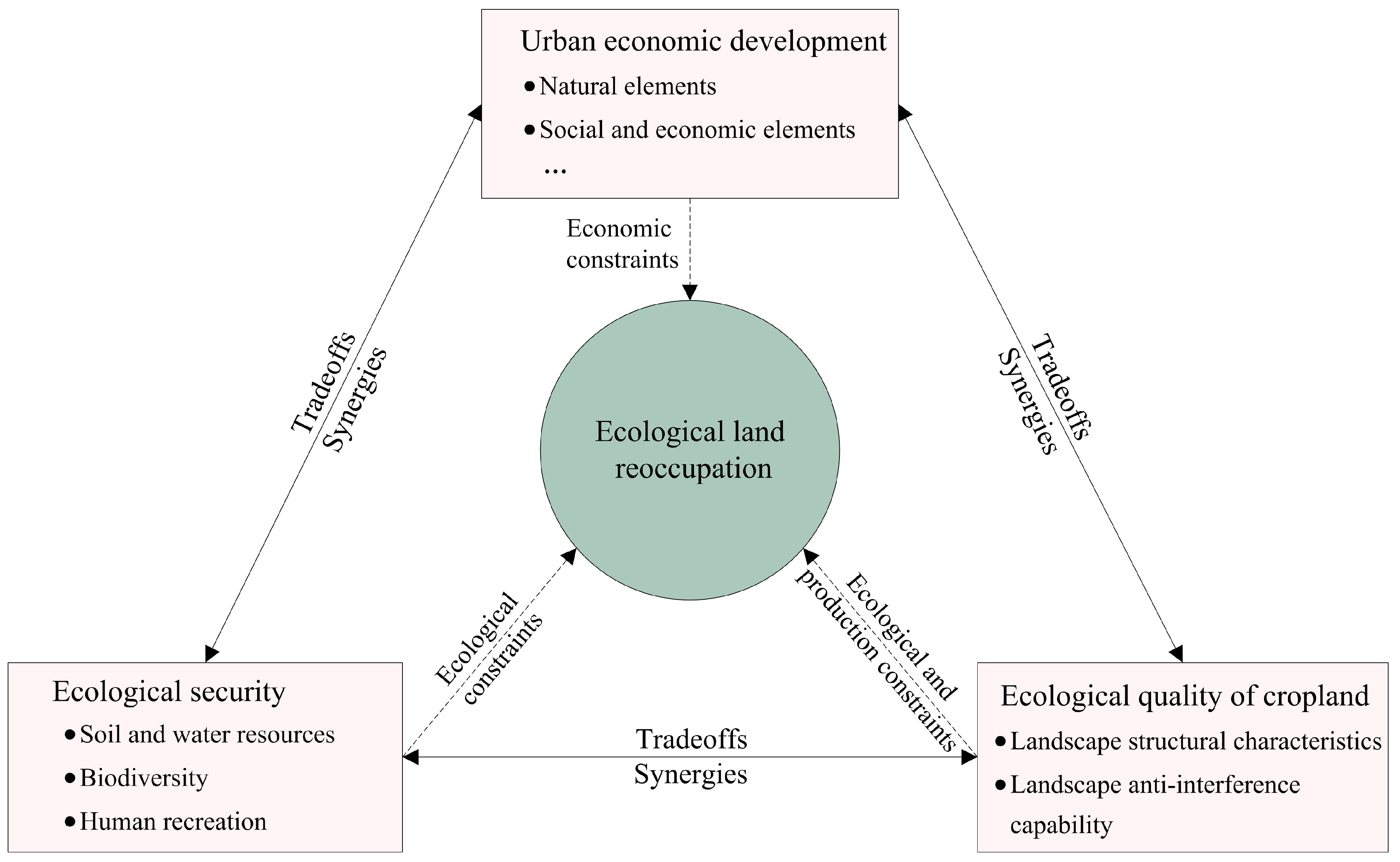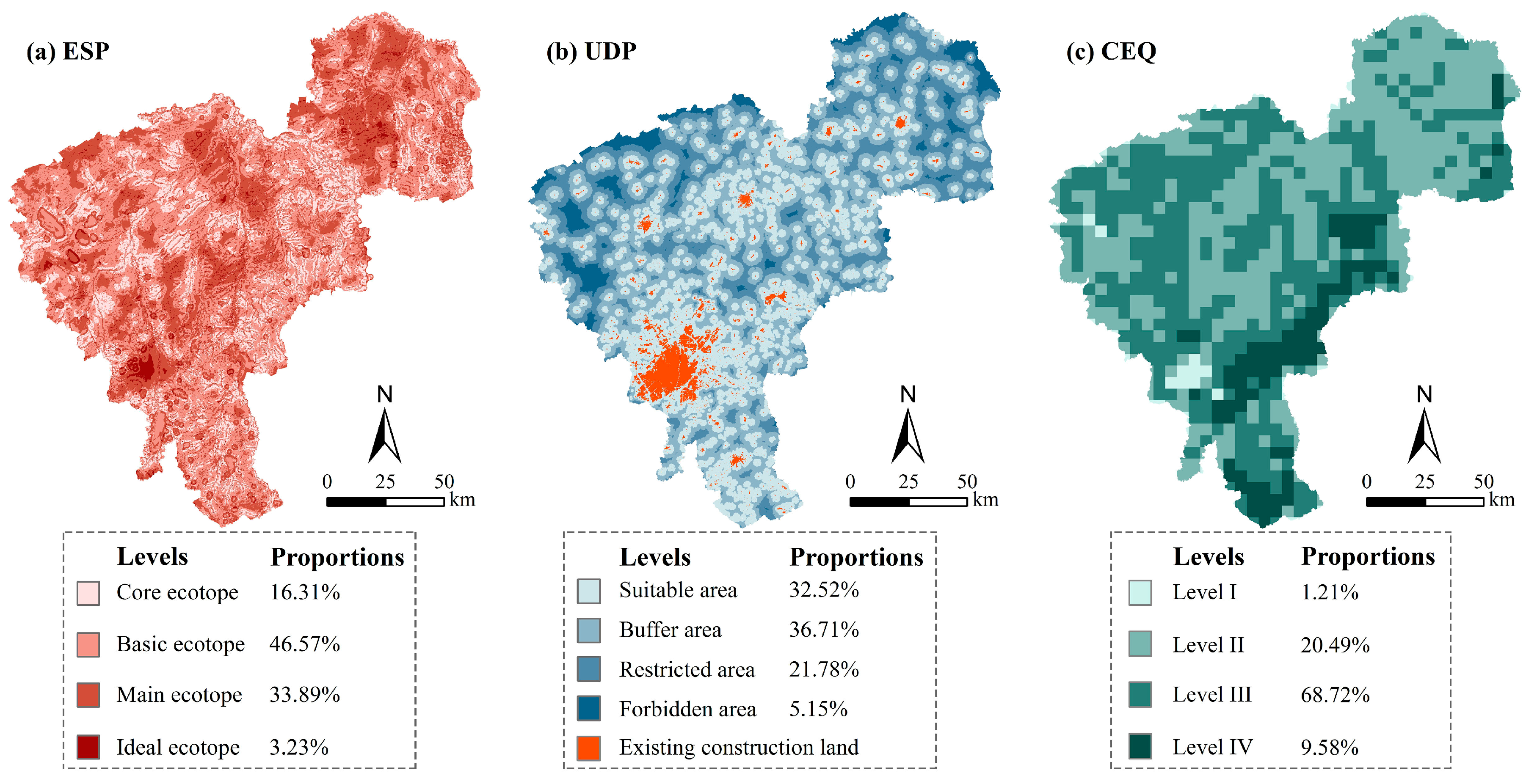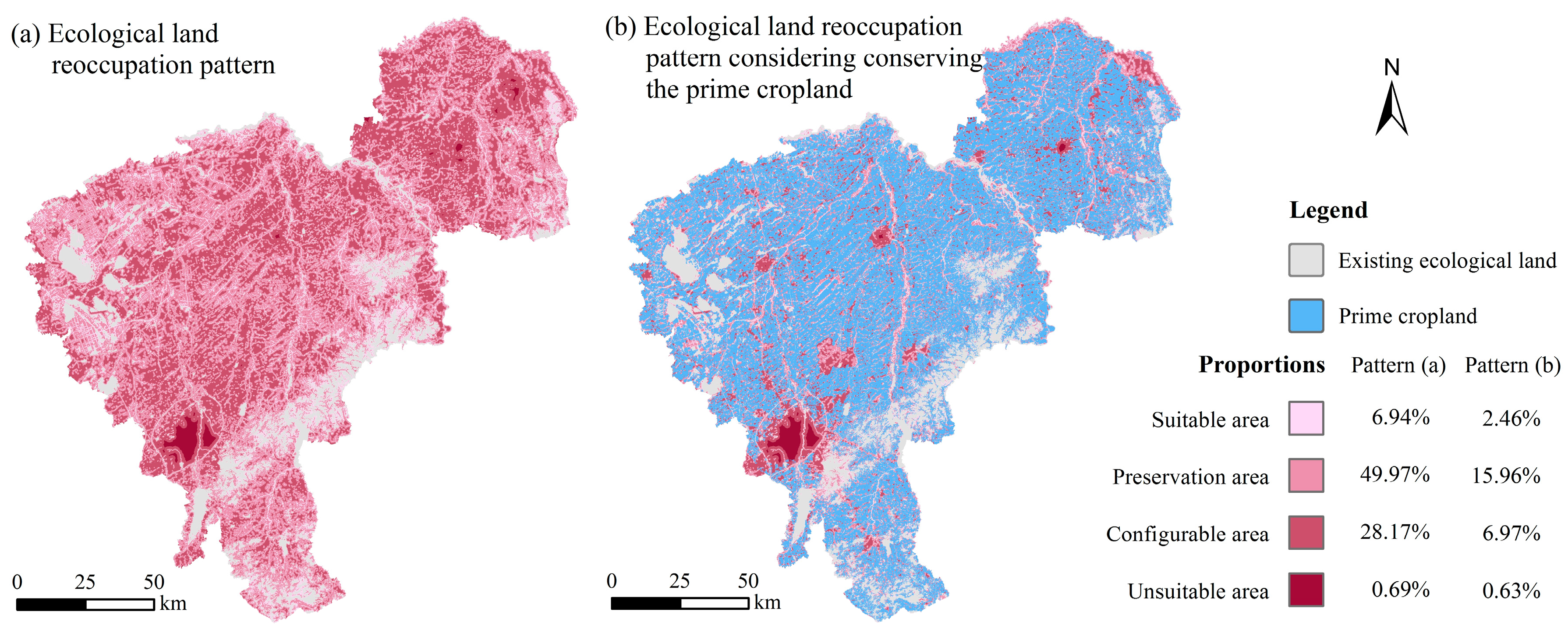Reoccupying Ecological Land for Excessively Expanded Rust Belt Cities in Traditional Grain Bases: An Eco-Economic Trade-Off Perspective
Abstract
1. Introduction
2. Materials and Methods
2.1. Study Area
2.2. Land Classification and Data Sources
2.3. Theoretical Framework of Ecological Land Optimization
2.4. Analysis Methods and Process
2.4.1. Minimal Cumulative Resistance Model
2.4.2. Analysis Procedure
3. Results
3.1. Spatial Distribution of the Constraint Elements
3.1.1. Ecological Security Pattern
3.1.2. Urban Development Pattern
3.1.3. Ecological Quality of Cropland
3.2. Simulation Results of Ecological Land Reoccupation Considering Single Constraints
3.3. Comprehensive Simulation Results of Ecological Land Reoccupation Considering Multiple Constraints
4. Discussion
4.1. Ecological Land Optimization Mode of Rust Belt Cities in Farming Areas
4.2. Managerial Implications
5. Conclusions
Supplementary Materials
Author Contributions
Funding
Acknowledgments
Conflicts of Interest
References
- Bai, X.M.; Chen, J.; Shi, P.J. Landscape urbanization and economic growth in China: Positive feedbacks and sustainability dilemmas. Environ. Sci. Technol. 2012, 46, 132–139. [Google Scholar] [PubMed]
- Cai, Z.Y.; Liu, Q.; Cao, S.X. Real estate supports rapid development of China’s urbanization. Land Use Policy 2020, 95, 104582. [Google Scholar] [CrossRef]
- Martin, D.J.; Chen, Y.W.; Simon, J.; Lu, H.Y.; Zhao, M.X.; Yang, Q.H.; Zhang, C.N. Explaining city branding practices in China’s three mega-city regions: The role of ecological modernization. J. Clean. Prod. 2018, 179, 527–543. [Google Scholar]
- Lambin, E.F.; Meyfroidt, P. Global land use change, economic globalization, and the looming land scarcity. Proc. Natl. Acad. Sci. USA 2011, 108, 3465–3472. [Google Scholar] [CrossRef]
- Song, W.; Bryan, C.P.; Amin, T. Urban expansion and its consumption of high-quality farmland in Beijing, China. Ecol. Indic. 2015, 54, 60–70. [Google Scholar] [CrossRef]
- Wang, J.L.; Zhou, W.Q.; Steward, T.A.P.; Yu, W.J.; Li, W.F. A multiscale analysis of urbanization effects on ecosystem services supply in an urban megaregion. Sci. Total Environ. 2019, 662, 824–833. [Google Scholar] [CrossRef]
- He, B.J.; Zhao, Z.Q.; Shen, L.D.; Wang, H.B.; Li, L.G. An approach to examining performances of cool/hot sources in mitigating/enhancing land surface temperature under different temperature backgrounds based on Landsat 8 image. Sustain. Cities Soc. 2018, 44, 416–427. [Google Scholar] [CrossRef]
- National Bureau of Statistics of China. Statistical Communiqué of the People’s Republic of China on the 2019 National Economic and Social Development; The National Bureau of Statistics of China: Beijing, China, 2020. (in Chinese) [Google Scholar]
- Chen, J. Rapid urbanization in China: A real challenge to soil protection and food security. Catena 2007, 69, 1–15. [Google Scholar] [CrossRef]
- Danish; Ulucak, R.; Khan, S.U.D. Determinants of the ecological footprint: Role of renewable energy, natural resources, and urbanization. Sustain. Cities Soc. 2020, 54, 101996. [Google Scholar] [CrossRef]
- Kuusaana, E.D.; Eledi, J.A. Customary land allocation, urbanization and land use planning in Ghana: Implications for food systems in the Wa Municipality. Land Use Policy 2015, 48, 454–466. [Google Scholar] [CrossRef]
- Guo, X.D.; Chang, Q.; Liu, X.; Bao, H.M.; Zhang, Y.P.; Tu, X.Y.; Zhu, C.X.; Lv, C.Y.; Zhang, Y.Y. Multi-dimensional eco-land classification and management for implementing the ecological redline policy in China. Land Use Policy 2018, 74, 15–31. [Google Scholar] [CrossRef]
- Zhang, Y.Z.; Hu, Y.F.; Zhuang, D.F. A highly integrated, expansible, and comprehensive analytical framework for urban ecological land: A case study in Guangzhou, China. J. Clean. Prod. 2020, 268, 122360. [Google Scholar] [CrossRef]
- Colding, J. ‘Ecological land-use complementation’ for building resilience in urban ecosystems. Landsc. Urban Plan. 2007, 81, 46–55. [Google Scholar] [CrossRef]
- Nguyen, K.A.; Liou, Y.A. Global mapping of eco-environmental vulnerability from human and nature disturbances. Sci. Total Environ. 2019, 664, 995–1004. [Google Scholar] [CrossRef]
- Zhang, Y.N.; Long, H.L.; Tu, S.S. Spatial identification of land use functions and their tradeoffs/synergies in China: Implications for sustainable land management. Ecol. Indic. 2019, 107, 105550. [Google Scholar] [CrossRef]
- Tan, Y.Z.; Zhao, Y.; Cao, Y.; He, J. Research Progress on Regional Ecological Land Classification in China. China Land Sci. 2016, 30, 28–36. (In Chinese) [Google Scholar]
- Zhou, R.; Wang, X.J.; Su, H.L.; Lou, Y.L. Identification and security pattern of ecological land in Pingdingshan newly developed area. Acta Ecol. Sin. 2015, 35, 2003–2012. (In Chinese) [Google Scholar]
- Wu, A.B.; Zhao, Y.X. Analysis of ecological land pattern evolution and ecosystem service value in Bashang plateau. Trans. Chin. Soc. Agric. Eng. 2017, 33, 283–290. (In Chinese) [Google Scholar]
- Ekkel, E.D.; De, V.S. Nearby green space and human health: Evaluating accessibility metrics. Landsc. Urban Plan. 2017, 157, 214–220. [Google Scholar] [CrossRef]
- Hasala, D.; Supak, S.; Rivers, L. Green infrastructure site selection in the Walnut Creek wetland community: A case study from southeast Raleigh, North Carolina. Landsc. Urban Plan. 2020, 196, 103743. [Google Scholar] [CrossRef]
- Afriyanie, D.; Julian, M.M.; Riqqi, A.; Akbar, R.; Djoko, S.A.S.; Kustiwan, I. Re-framing urban green spaces planning for flood protection through socio-ecological resilience in Bandung City, Indonesia. Cities 2020, 101, 102710. [Google Scholar] [CrossRef]
- Bertram, C.; Rehdanz, K. The role of urban green space for human well-being. Ecol. Econ. 2015, 120, 139–152. [Google Scholar] [CrossRef]
- Sharifi, E.; Larbi, M.; Omrany, H.; Boland, J. Climate change adaptation and carbon emissions in green urban spaces: Case study of Adelaide. J. Clean. Prod. 2020, 254, 120035. [Google Scholar] [CrossRef]
- Jiang, B.; Bai, Y.; Wong, C.P.; Xu, X.B.; Alatalo, J.M. China’s ecological civilization program-Implementing ecological redline policy. Land Use Policy 2019, 81, 111–114. [Google Scholar] [CrossRef]
- Gao, J.; Zou, C.; Zhang, K.; Xu, M.J.; Wang, Y. The establishment of Chinese ecological conservation redline and insights into improving international protected areas. J. Environ. Manag. 2020, 264, 110505. [Google Scholar] [CrossRef]
- Deng, X.Z.; Huang, J.K.; Rozelle, S.; Uchida, E. Cultivated land conversion and potential agricultural productivity in China. Land Use Policy 2006, 23, 372–384. [Google Scholar] [CrossRef]
- Xie, L.; Yang, Z.S.; Cai, J.M.; Cheng, Z.; Wen, T.; Song, T. Harbin: A rust belt city revival from its strategic position. Cities 2016, 58, 26–38. [Google Scholar] [CrossRef]
- Pei, P.; Fan, Y. Study on Revitalizing Northeast China through a new road of industrialization. Can. Soc. Sci. 2008, 4, 74–80. [Google Scholar]
- Liu, S.H.; Wang, D.Y.; Lei, G.P.; Li, H.; Li, W.B. Elevated risk of ecological land and underlying factors associated with rapid urbanization and overprotected agriculture in northeast China. Sustainability 2019, 11, 6203. [Google Scholar] [CrossRef]
- Li, W.B.; Wang, D.Y.; Li, H.; Wang, J.G.; Zhu, Y.L.; Yang, Y.W. Quantifying the spatial arrangement of underutilized land in a rapidly urbanized rust belt city: The case of Changchun City. Land Use Policy 2019, 83, 113–123. [Google Scholar] [CrossRef]
- Mao, D.H.; He, X.Y.; Wang, Z.M.; Tian, Y.L.; Xiang, H.X.; Yu, H.; Man, W.D.; Jia, M.M.; Ren, C.Y.; Zheng, H.F. Diverse policies leading to contrasting impacts on land cover and ecosystem services in Northeast China. J. Clean. Prod. 2019, 240, 117961. [Google Scholar] [CrossRef]
- Liu, L.; Liu, Z.J.; Gong, J.Z.; Wang, L.; Hu, Y.M. Quantifying the amount, heterogeneity, and pattern of farmland: Implications for China’s requisition-compensation balance of farmland policy. Land Use Policy 2019, 81, 256–266. [Google Scholar] [CrossRef]
- Zhou, H.; Lei, G.P.; Yang, X.X. Land Use Change Pattern and Its Spatial Differentiation in Typical Basin of Sanjiang Plain. Trans. Chin. Soc. Agric. Mach. 2017, 48, 142–151. (In Chinese) [Google Scholar]
- Thomas, H. Decisions with multiple objectives: Preferences and value trade-offs. J. Oper. Res. Soc. 1977, 28, 602–603. [Google Scholar]
- Rodrígue, J.P.; Douglas, B.T.; Bennett, E.M.; Cumming, G.S. Trade-offs across space, time, and ecosystem services. Ecol. Soc. 2005, 11, 709–723. [Google Scholar]
- Zhang, B.L.; Jiang, G.H.; Qu, Y.B. Trade-off of productive and dwelling space of rural settlement in developed areas. Trans. Chin. Soc. Agric. Eng. 2019, 35, 253–261. (In Chinese) [Google Scholar]
- Zhang, S.Y.; Shi, Z.Q.; Song, X.Q.; Deng, W. Space trade-offs analysis in the urban floating population residential self-selection: A case study of Chengdu. Geogr. Res. 2018, 37, 2554–2566. [Google Scholar]
- Fu, Y.J.; Shi, X.Y.; He, J.; Yuan, Y.; Qu, L.L. Identification and optimization strategy of county ecological security pattern: A case study in the Loess Plateau, China. Ecol. Indic. 2020, 112, 106030. [Google Scholar] [CrossRef]
- Wang, R.H.; Li, X.Y.; Zhang, S.W.; Li, Y.B.; Cao, C. Research for landscape ecological security pattern and early warning in farming-pastoral zone of northeast China: A case study of Tongyu County in Jilin Province. Geogr. Geo-Inf. Sci. 2014, 30, 111–115. (In Chinese) [Google Scholar]
- Mao, D.H.; Wang, Z.M.; Wu, J.G.; Wu, B.F.; Zeng, Y.; Song, K.S.; Yi, K.P.; Luo, L. China’s wetlands loss to urban expansion. Land Degrad. Dev. 2018, 29, 2644–2657. [Google Scholar] [CrossRef]
- Azhdari, A.; Sasani, M.A.; Soltani, A. Exploring the relationship between spatial driving forces of urban expansion and socioeconomic segregation: The case of Shiraz. Habitat Int. 2018, 81, 33–44. [Google Scholar] [CrossRef]
- Luo, J.J.; Zhang, X.L.; Wu, Y.Z.; Shen, J.H.; Shen, L.Y.; Xing, X.S. Urban land expansion and the floating population in China: For production or for living? Cities 2017, 74, 219–228. [Google Scholar] [CrossRef]
- Pei, H.; Wei, Y.; Wang, X.; Qin, Z.; Hou, C. Method of cultivated land landscape ecological security evaluation and its application. Trans. Chin. Soc. Agric. Eng. 2014, 30, 212–219. (In Chinese) [Google Scholar]
- Knaapen, J.P.; Scheffer, M.; Harms, B. Estimating habitat isolation in landscape planning. Landsc. Urban Plan. 1992, 23, 1–16. [Google Scholar] [CrossRef]
- Yu, K.J. Security patterns and surface model in landscape ecological planning. Landsc. Urban Plan. 1996, 36, 1–17. [Google Scholar] [CrossRef]
- Pan, J.H.; Liu, X. Assessment of landscape ecological security and optimization of landscape pattern based on spatial principal component analysis and resistance model in arid inland area: A case study of Ganzhou District, Zhangye City, Northwest China. Chin. J. Appl. Ecol. 2015, 26, 3126–3136. (In Chinese) [Google Scholar]
- Liu, X.F.; Shu, J.M.; Zhang, L.B. Research on applying minimal cumulative resistance model in urban land ecological suitability assessment: As an example of Xiamen City. Acta Ecol. Sin. 2010, 30, 421–428. (In Chinese) [Google Scholar]
- Jenks, G.F. The data model concept in statistical mapping. Int. Yearb. Cartogr. 1967, 7, 186–190. [Google Scholar]
- Liu, S.H.; Wang, D.Y.; Li, H.; Li, W.B.; Zhu, Y.L.; Wu, W.J. The Ecological Security Pattern and Its Constraint on Urban Expansion of a Black Soil Farming Area in Northeast China. ISPRS Int. J. Geo-Inf. 2017, 6, 263. [Google Scholar]
- Huang, M.Y.; Yue, W.Z.; Feng, S.R.; Cai, J.J. Analysis of spatial heterogeneity of ecological security based on MCR model and ecological pattern optimization in the Yuexi county of the Dabie Mountain Area. J. Nat. Resour. 2019, 34, 771–784. (In Chinese) [Google Scholar]
- Wang, S.Y.; Ou, M.H. Zoning for regulating of construction land based on landscape security pattern. Acta Ecol. Sin. 2013, 33, 4425–4435. (In Chinese) [Google Scholar]
- Meng, J.J.; Wang, Y.; Wang, X.D.; Zhou, Z.; Sun, N. Construction of landscape ecological security pattern in Guiyang based on MCR model. Resour. Environ. Yangtze Basin 2016, 25, 1052–1061. (In Chinese) [Google Scholar]
- Su, Y.X.; Zhang, H.O.; Chen, X.Z.; Huang, G.Q.; Ye, Y.Y.; Wu, Q.T.; Huang, N.S.; Kuang, Y.Q. The ecological security patterns and construction land expansion simulation in Gaoming. Acta Ecol. Sin. 2013, 33, 1524–1534. (In Chinese) [Google Scholar]
- Marciniak, R.W.; Sikorska, D.; Krauze, K. Residents’ awareness of the role of informal green spaces in a post-industrial city, with a focus on regulating services and urban adaptation potential. Sustain. Cities Soc. 2020, 59, 102236. [Google Scholar] [CrossRef]
- Draus, P.; Roddy, J.; Mcduffie, A. “It’s about half and half”: Austerity, possibility and daily life inside a depopulated Detroit neighborhood. City Cult. Soc. 2018, 14, 37–46. [Google Scholar] [CrossRef]
- Hu, X.H.; Yang, C. Building a role model for rust belt cities? Fuxin’s economic revitalization in question. Cities 2017, 72, 245–251. [Google Scholar] [CrossRef]
- Jakar, G.S.; Dunn, J.R. (Turning Rust into Gold?) Hamilton, Ontario and a Canadian perspective of shrinking and declining cities. Cities 2019, 94, 1–10. [Google Scholar] [CrossRef]
- Guo, Y.H.; Tong, L.J.; Mei, L. The effect of industrial agglomeration on green development efficiency in Northeast China since the revitalization. J. Clean. Prod. 2020, 258, 120584. [Google Scholar] [CrossRef]
- Mao, D.H.; Luo, L.; Wang, Z.M.; Wilson, M.C.; Zeng, Y.; Wu, B.F.; Wu, J.G. Conversions between natural wetlands and farmland in China: A multiscale geospatial analysis. Sci. Total Environ. 2018, 634, 550–560. [Google Scholar] [CrossRef]
- Liu, T.; Liu, H.; Qi, Y.J. Construction land expansion and cultivated land protection in urbanizing China: Insights from national land surveys, 1996–2006. Habitat Int. 2015, 46, 13–22. [Google Scholar] [CrossRef]
- Hu, M.M.; Xia, B.C. A significant increase in the normalized difference vegetation index (NDVI) during the rapid economic development in the Pearl River Delta of China. Land Degrad. Dev. 2018, 30, 359–370. [Google Scholar]
- Wang, Y.H.; Brandt, M.; Zhao, M.F.; Xing, K.X.; Wang, L.H.; Tong, X.W.; Xue, F.; Kang, M.Y.; Jiang, Y.; Fensholt, R. Do afforestation projects increase core forests? Evidence from the Chinese Loess Plateau. Ecol. Indic. 2020, 117, 106558. [Google Scholar] [CrossRef]
- Li, F.; Tian, C.H. Construction land quotas as a tool for managing urban expansion. Landsc. Urban Plan. 2020, 195, 103727. [Google Scholar]






| Constraints | Resistance Surface | Classification | Descriptions | Resistance Coefficients |
|---|---|---|---|---|
| Ecological security | Ecological security pattern | Core ecotope | The core ecotope is the crucial area that guarantees the key ecological process, and construction activities should be strictly prohibited in this region. The basic ecotope and the main ecotope could meet most ecosystem service requirements with great potential for improvement. The ideal ecotope refers to the area that can maximize the ecological benefits of land use, which is an optimal situation. | 10 |
| Basic ecotope | 20 | |||
| Main ecotope | 50 | |||
| Ideal ecotope | 100 | |||
| Urban development | Urban development pattern | Suitable area | The urban development pattern could represent the suitability of economic activities. Considering the perspective of ecological priority, the forbidden area is the bottom line for ecological land protection. The suitable area, the buffer area and the restricted area can be developed according to their resistance values from small to large. | 100 |
| Buffer area | 50 | |||
| Restricted area | 20 | |||
| Forbidden area | 10 | |||
| Ecological quality of cropland | Levels of cropland ecological quality | Level I | The higher the level of CEQ is, the better the ability of cropland to withstand external interferences. Optimizing the quantity and structure of the ecological land in low ecological quality areas would enhance the ecosystem service function of cropland and mitigate the risks. | 100 |
| Level II | 50 | |||
| Level III | 20 | |||
| Level IV | 10 |
© 2020 by the authors. Licensee MDPI, Basel, Switzerland. This article is an open access article distributed under the terms and conditions of the Creative Commons Attribution (CC BY) license (http://creativecommons.org/licenses/by/4.0/).
Share and Cite
Liu, S.; Lei, G.; Wang, D.; Li, H.; Li, W.; Gao, J. Reoccupying Ecological Land for Excessively Expanded Rust Belt Cities in Traditional Grain Bases: An Eco-Economic Trade-Off Perspective. Land 2020, 9, 297. https://doi.org/10.3390/land9090297
Liu S, Lei G, Wang D, Li H, Li W, Gao J. Reoccupying Ecological Land for Excessively Expanded Rust Belt Cities in Traditional Grain Bases: An Eco-Economic Trade-Off Perspective. Land. 2020; 9(9):297. https://doi.org/10.3390/land9090297
Chicago/Turabian StyleLiu, Shuhan, Guoping Lei, Dongyan Wang, Hong Li, Wenbo Li, and Jia Gao. 2020. "Reoccupying Ecological Land for Excessively Expanded Rust Belt Cities in Traditional Grain Bases: An Eco-Economic Trade-Off Perspective" Land 9, no. 9: 297. https://doi.org/10.3390/land9090297
APA StyleLiu, S., Lei, G., Wang, D., Li, H., Li, W., & Gao, J. (2020). Reoccupying Ecological Land for Excessively Expanded Rust Belt Cities in Traditional Grain Bases: An Eco-Economic Trade-Off Perspective. Land, 9(9), 297. https://doi.org/10.3390/land9090297






